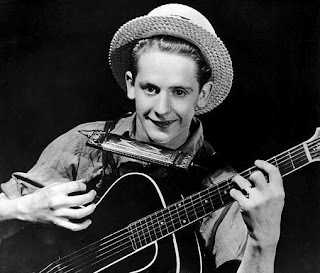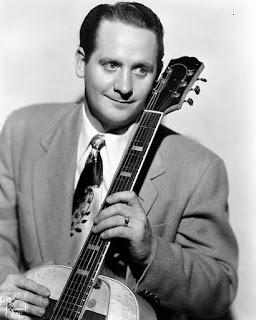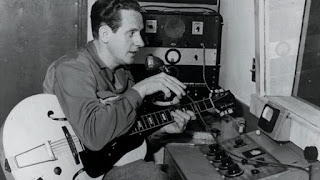Lester William Polsfuss (June 9, 1915 – August 12, 2009), known as Les Paul, was an American jazz, country, and blues guitarist, songwriter, luthier, and inventor. He was one of the pioneers of the solid-body electric guitar, and his techniques served as inspiration for the Gibson Les Paul.
 Born Lester William Polfuss in 1915 in Waukesha, Wisconsin, Paul built his first crystal radio at age 9—which was about the time he first picked up a guitar. By age 13 he was performing semi-professionally as a country-music guitarist and working diligently on sound-related inventions. In 1941 Paul built his first solid-body electric guitar, and he continued to make refinements to his prototype throughout the decade. It’s safe to say that rock and roll as we know it would not exist without his invention.
Born Lester William Polfuss in 1915 in Waukesha, Wisconsin, Paul built his first crystal radio at age 9—which was about the time he first picked up a guitar. By age 13 he was performing semi-professionally as a country-music guitarist and working diligently on sound-related inventions. In 1941 Paul built his first solid-body electric guitar, and he continued to make refinements to his prototype throughout the decade. It’s safe to say that rock and roll as we know it would not exist without his invention.But Les Paul didn’t stop there. He also refined the technology of sound recording, developing revolutionary engineering techniques. He also busied himself as a versatile bandleader and performer who could play jazz, country and pop.
The guitar that bears his name—the Gibson Les Paul—is his crowning achievement. It grew out of his desire, as a musician and inventor, to create a stringed instrument that could make electronic sound without distorting. What he came up with, after almost a decade of work, was a solid-bodied instrument—that is, one that didn’t have the deep, resonant chamber of an acoustic guitar. Paul was beaten to the marketplace by Leo Fender, whose Fender Broadcaster—the first mass-produced solid-body electric guitar—was introduced in 1948. That same year, however, Paul
![]() unveiled overdubbing, a breakthrough recording technique that would forever change music. Capitol Records released the Paul’s experimental eight-track recordings of “Lover (When You’re Near Me)” and “Brazil,” which he made in his garage workshop.
unveiled overdubbing, a breakthrough recording technique that would forever change music. Capitol Records released the Paul’s experimental eight-track recordings of “Lover (When You’re Near Me)” and “Brazil,” which he made in his garage workshop.
 unveiled overdubbing, a breakthrough recording technique that would forever change music. Capitol Records released the Paul’s experimental eight-track recordings of “Lover (When You’re Near Me)” and “Brazil,” which he made in his garage workshop.
unveiled overdubbing, a breakthrough recording technique that would forever change music. Capitol Records released the Paul’s experimental eight-track recordings of “Lover (When You’re Near Me)” and “Brazil,” which he made in his garage workshop.Paul’s career as a musician nearly came to an end in 1948, when he suffered near-fatal car accident in Oklahoma, skidding off a bridge into a river during a snowstorm. The guitarist shattered his right arm and elbow, and he also broke his back, ribs, nose and collarbone. He managed to salvage his career as a musician by instructing surgeons to set his arm at an angle that would allow him to cradle and pick the guitar. It took him a year and a half to recover.
Paul subsequently made his mark as a jazz-pop musician extraordinaire, recording as a duo with his wife, singer Mary Ford (who was born Colleen Summers). Their biggest hits included “How High the Moon” (1951) and “Vaya Con Dios” (1953), both reaching Number One.
The recordings of Les Paul and Mary Ford are noteworthy for Paul’s pioneering use of overdubbing. He also speeded up the sound of his guitar. The results were bright, bubbly and a little otherworldly—just the sort of music you might expect from an inventor with an ear for the future.
The recordings of Les Paul and Mary Ford are noteworthy for Paul’s pioneering use of overdubbing. He also speeded up the sound of his guitar. The results were bright, bubbly and a little otherworldly—just the sort of music you might expect from an inventor with an ear for the future.
 In 1952 Les Paul introduced the first eight-track tape recorder (designed by Paul and marketed by Ampex) and, more significantly for the future of rock and roll, finally saw the release of the gold-top solid-body electric guitar that bears his name. Gibson’s Les Paul Standard went on to become one of the most popular of all models of electric guitar and is a staple instrument among many of rock’s greatest guitarists. He introduced the latest model in 2008. According to Gibson U.S.A., its design amendments include “a new asymmetrical neck profile that makes it one of the most comfortable and playable necks ever offered on any guitar.”
In 1952 Les Paul introduced the first eight-track tape recorder (designed by Paul and marketed by Ampex) and, more significantly for the future of rock and roll, finally saw the release of the gold-top solid-body electric guitar that bears his name. Gibson’s Les Paul Standard went on to become one of the most popular of all models of electric guitar and is a staple instrument among many of rock’s greatest guitarists. He introduced the latest model in 2008. According to Gibson U.S.A., its design amendments include “a new asymmetrical neck profile that makes it one of the most comfortable and playable necks ever offered on any guitar.”Over the ensuing decades Les Paul has remained active on all fronts. He recorded a Grammy-winning album of instrumental duets with Chet Atkins, Chester and Lester, in 1976. From the mid-Eighties through the mid-Nineties, he performed weekly at Fat Tuesday’s, a New York City jazz club. In 2005, at the age of 90, he released American Made/World Played, which featured guest spots from several of his most illustrious rock and roll disciples and won him a pair of Grammys.
Paul performed weekly at New York’s Iridium Jazz Club and indulged his inventor’s curiosity in a basement workshop at home in Mahwah, New Jersey up until his death on August 13, 2009. He died of complications from pneumonia at White Plains Hospital in White Plains, New York. After hearing about his death, many musicians commented on his importance. Slash called him "vibrant and full of positive energy", while Richie Sambora called him a "revolutionary in the music business".
The Edge said, "His legacy as a musician and inventor will live on and his influence on rock and roll will never be forgotten." On August 21, 2009, he was buried in Prairie Home Cemetery, Waukesha, Wisconsin.
The Edge said, "His legacy as a musician and inventor will live on and his influence on rock and roll will never be forgotten." On August 21, 2009, he was buried in Prairie Home Cemetery, Waukesha, Wisconsin.
(Edited from Wikipedia mainly rockhall.com)






